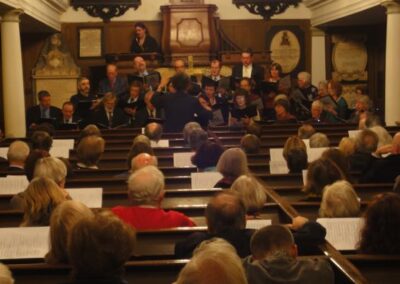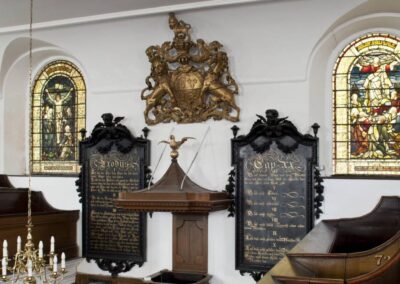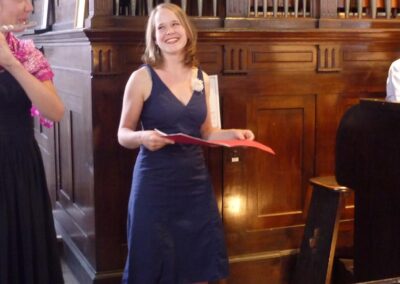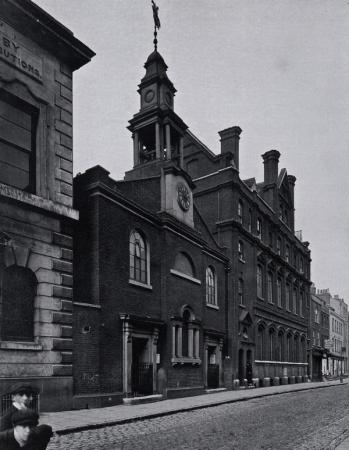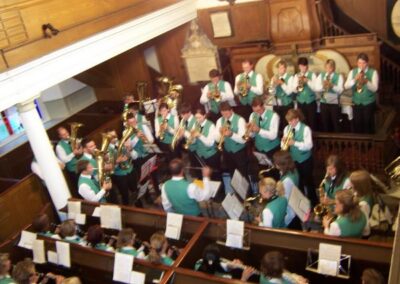St George's German Lutheran Church
St George’s is the oldest surviving German Church in the British Isles, opened in 1762.
German speakers – mostly religious refugees from the German speaking lands not yet united as modern Germany – ran most of the sugar refining industry in London and this was based in the area around Aldgate, where St George’s church is sited.
Today only the church and its former school adjacent are left to remind us of this huge refugee population in an area once called ‘Little Germany’. The history of this part of London is one of successive waves of immigration: Huguenots, German speakers, Jews, Bangladeshis. Today the German episode in this story is far less known even though Aldgate and Whitechapel was home to the largest German speaking population outside the German lands for over a century.
Directions
St George’s German Lutheran Church is 3 minutes from Aldgate East Underground and 5 minutes from Aldgate Underground. Many bus routes pass nearby. Fenchurch Street and Liverpool Street rail stations are both a 10 minute walk.
There are two steps into the Church. A ramp is available for wheelchair access to ground floor. There is no lift to the gallery and organ on first floor. Parking in neighbouring streets is severely restricted, so public transport is recommended.
In the area
There are nearby places of worship connected with immigration to central and East London including Bevis Marks Synagogue the oldest surviving synagogue in the UK which is open for visits at certain times, Sandys Row Synagogue which can arrange guided tours for groups and which occupies a building formerly a Huguenot chapel. East London Mosque is a short walk away. So too is Christ Church Spitalfields an internationally celebrated building by Nicholas Hawksmoor, built for the Church of England, partly in reaction to the nonconformism and religious dissent of East London.
Address
55 Alie Street
Aldgate
London
E1 8EB
United Kingdom
St George’s is open by arrangement for group visits and with notice we try to provide a volunteer speaker to talk about the building.
St George’s dates from 1762–3 and is now the oldest German church in Britain. It served as a religious centre for generations of German immigrants who worked in the East End sugar refineries and in the meat and baking trades right up until the congregation decided to merge with another German Lutheran congregation, and left St George’s in 1996. The area around Aldgate was known as ‘Little Germany’ and for much of the 19th century was the largest concentration of German-speaking people outside the German homelands.
Inside, the church retains remarkable furnishings, including a complete set of box pews and fine, central double-decker pulpit. At the ‘east end’ hangs the coat-of-arms of King George III (pre-1801) and two carved timber commandment boards in German. The Royal Arms, adopted by the congregation as a mark of loyalty, recall a connection with the Duchess of Kent, mother of Queen Victoria, who was patron of the adjacent German and English schools from 1819. There are 18th and l9th-century memorials, many in German, and a fine German Walcker organ.
During the Nazi period in Germany, St George’s pastor, Julius Rieger, worked strenuously to assist Protestant Christians of Jewish descent (and therefore deemed to be Jewish and persecuted by the Nazi regime) to flee to England. Led by Julius Rieger, St George’s also provided a spiritual home and much needed ongoing practical support to Protestant refugees already in the country. Fortunately correspondence survives in several archives and the full extent of Pastor Rieger’s work is now being recorded by a London based Phd student. The leading theologian and anti-Nazi activist Dietrich Bonhoeffer was also associated with the work of St George’s when Bonhoeffer was pastor at the nearby St Paul’s church from 1933 to 1935. The former congregation marked the centenary of Bonhoeffer’s birth with a special service in 2006.
The Church is a Grade II* listed building and was acquired by HCT in 1999.
HCT tackled its long-standing disrepair and serious structural problems discretely, so that most people are surprised that nearly £1m of restoration work was carried out. Works were generously funded by Historic England and the Heritage Lottery Fund.
St George’s is registered for religious marriages in the German Lutheran tradition and the service can be conducted in German or English at the couple’s choice. To enquire about getting married at St Georges please contact us.
Family history records of the congregation have been deposited for conservation and safe-keeping at the London Borough of Tower Hamlets Local History Library and Archives

